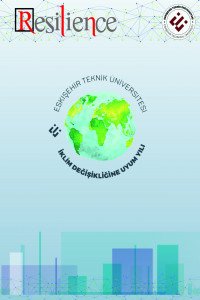Kültürel Miras Üzerinden Dirençlilik: Gölcük’te Mimari Korumanın Deprem Sonrası Zorlukları
Geleneksel çevre, öğrenilmiş bilgilerin kullanıcılarına sürdürülebilirlik ve dirençlilik bağlamında aktarılmasını sağlamaktadır. Buna karşılık Kocaeli ili Gölcük ilçesindeki tarihi yapılı çevre incelendiğinde, yönetimde bulunan paydaşların tutarsız yaklaşımları gözlemlenmektedir. 1999 depreminden sonra görülen yeni inşaat faaliyetleri ve alanın hiçbir değerini yansıtmayan hatalı koruma yaklaşımları olarak tanımlanan kentsel dönüşüm projeleri, kültürel mirasın sürekliliğini tehdit etmektedir. Bu çalışmada, Gölcük çevresinde nispeten yoğun geleneksel yapılara sahip olan iki farklı mahalle olan Örcün ve Saraylı örnek vaka olarak ele alınmıştır. Deprem sonrası çalışmalar, mimari dokunun betonarme yapıların inşası ile büyük oranda değiştiğini göstermektedir. Depremden 20 yıl sonra kent dirençliliğini araştırmak üzere mahallelerin kentsel, mimari ve sosyal yönlerinin araştırılması hedeflenmiştir. Tescilli ve tescilsiz gelenek yapıların güncel durumlarını belirlemek, geleneksel yöntemlerin yeni yapılı çevredeki etkilerini değerlendirmek ve geleneksel ustalık ve teknoloji ile yeni kent politikalarının sosyal olarak eğilimini ortaya çıkarmak amaçlanmıştır.
Anahtar Kelimeler:
Kırsal miras, koruma, sürdürülebilirlik, dirençlilik
Resilience over Cultural Heritage: The Post-Earthquake Challenges of Architectural Conservation in Gölcük
Vernacular environment presents the learned lessons transferred to the inhabitants in terms of sustainability and resilience. On the contrary, stakeholders participated in the administrative tasks display inconsistent approaches towards the historic built environment especially in Gölcük, Kocaeli. After the 1999 earthquake urban transformation projects as new constructions and improper conservation practices without any values of the area threatens the continuity of the cultural heritage. The discussions were mainly focused on two different neighborhoods Örcün and Saraylı having relatively intense vernacular buildings in the periphery of Gölcük. The post-disaster studies revealed that architecture tissues were dramatically changed in the favor of reinforced concrete especially in urban areas. Three main objectives were sought in order to evaluate the resilience after 20 years in terms of urban, architectural and social aspects. It is aimed to determine the current conditions of listed and non-listed traditional structures; to assess the impact of vernacular systems on the new built environment and to reveal the social tendency toward new urban policy with traditional ingenuity and technology.
Keywords:
Rural heritage, conservation, sustainability, resilience,
___
- Ambraseys, N. N. (2001). “The earthquake of 10 July 1894 in the Gulf of Izmit (Turkey) and its relation to the earthquake of 17 August 1999”, Journal of Seismic Exploration, vol. 5, pp. 117-128.
- Bretonne, C. (1979). “An Interview with Amos Rapoport on Vernacular Architecture”. METU Journal of the Faculty of Architecture, vol. 5/2, pp. 113-126.
- Boccardi, G. and Scott, L. (April 2014). “Developing a proposal for the integration of a sustainable development perspective within the processes of the World Heritage Convention”, working document, version. Available at http://whc.unesco.org/document/128769 [Accessed: 05 March 2019, 22:44].
- Eiser, J. R., Bostrom, A., Burton, I., Johnston, D. M., McClure, J., Paton, D., van der Pligt, J. and White, M. P. (2012) “Risk interpretation and action: a conceptual framework for responses to natural hazards”, International Journal of Disaster Risk Reduction, 2012, vol. 1, pp.5-16.
- Galitekin, A. N. (2005). Gölcük Tarihçe ve Kültür Mirası Eserler, Gölcük: Gölcük Belediyesi Kültür Yayınları No:6.
- Intergovernmental Panel on Climate Change (IPCC) (2012). “Managing the Risks of Extreme Events and Disasters to Advance Climate Change Adaptation. A Special Report of Working Groups I and II of the Intergovernmental Panel on Climate Change” [Field, C.B., V. Barros, T.F. Stocker, D. Qin, D.J. Dokken, K.L. Ebi, M.D. Mastrandrea, K.J. Mach, G.-K. Plattner, S.K. Allen, M. Tignor, and P.M. Midgley (eds.)]. Cambridge University Press, Cambridge, UK, and New York, NY, USA.
- Köksal, G. (2012). Gölcük Mimari Miras, Gölcük Vizyon 2023, Kocaeli: Kültür Vizyon Serisi 3.
- Köksal, G. and Kishalı, E. (2012). “Inventory of Vernacular Architecture in Gölcük and Sustainable Solutions for its Conservation”, Proceedings of 6th International Seminar on Vernacular Settlements, 19 – 21 April 2012, Eastern Mediterranean University, Famagusta, Northern Cyprus, pp. 171 – 180.
- Özmen, B. (2000). 17 Ağustos 1999 İzmit Körfezi Depreminin Hasar Durumu (Rakamsal Verilerle), TDV/DR 010-53, Türkiye Deprem Vakfı, p. 22.
- Rajčić, V. and Žarnić, R. (2016). “Risk and Resilience of Cultural Heritage Assets” Proceedings of SBE16 Malta International Conference Europe and the Mediterranean towards a Sustainable Built Environment, Malta: Gutenberg Press, pp. 325-333.
- UNESCO World Heritage Centre, International Council on Monuments and Sites – International Scientific Committee on Risk Preparedness, International Centre for the Study of the Preservation and Restoration of Cultural Property and MARSH International, (2013). “Heritage and Resilience: Issues and Opportunities for Reducing Disaster Risks”, Geneva, Switzerland, chapter 2.
- United Nation Office for Disaster Risk Reduction (UNISDR) (2012). “Venice declaration on building resilience at the local level towards protected cultural heritage and climate change adaptation strategies”, Italy.
- Yayın Aralığı: Yılda 2 Sayı
- Başlangıç: 2017
- Yayıncı: Eskişehir Teknik Üniversitesi
Sayıdaki Diğer Makaleler
Depremden Sonra Psikolojik İlk Yardım ve Sosyal Hayata Dönüş
Türkiye’de Mimarlık ve İç Mimarlık Öğretiminde Yangın Güvenliğine Samsun Özelinden Bakış
Yunanistan Attika Bölgesi Yangınının Değerlendirilmesi
Sevda DEMİRÖZ YILDIRIM, Gürkan YILMAZ
Aynur ULUÇ, Meltem ŞENOL-BALABAN
Küresel İklim Değişikliğinin Kaçınılmaz Sonucu: Kuraklık
Nur Sinem PARTİGÖÇ, Sevde SOĞANCI
Antroposen Çağı’nda Kentsellik, Sürdürülebilirlik ve Dirençlilik
İnşaat Sektörünün Dayanıklılığını Konut Sunumunun Ötesinde Aramak
Kültürel Miras Üzerinden Dirençlilik: Gölcük’te Mimari Korumanın Deprem Sonrası Zorlukları
